Kraków 2017-04-22
History
Section 1954.03.04.
Lockheed F-104 Starfighter against OKB Mikojan and Guriewicz MiG-21.
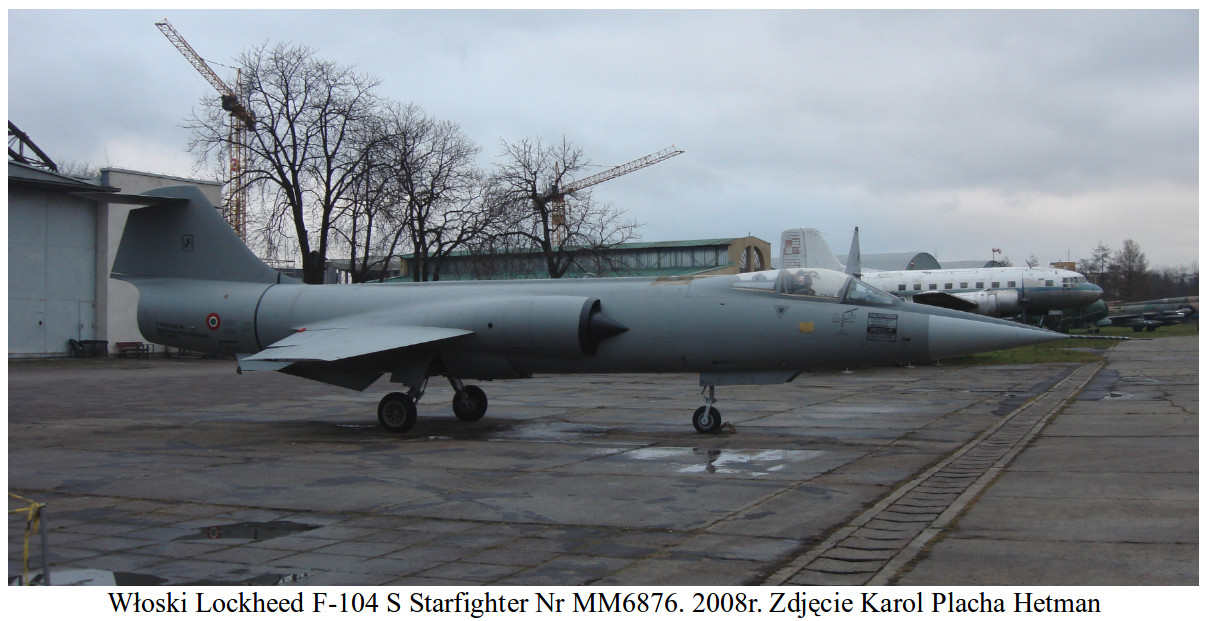
At the Polish Aviation Museum in Czyżyny in Krakow, there are currently (2017) two Lockheed F-104 Starfighters. The first is the Lockheed F-104 S ASA-M Starfighter No. MM6876 built in Italy. The aircraft was used in the 9th Fighter Wing. He made his last operational flight on September 30, 2004, and his last test flight on July 27, 2005. The plane without an engine was delivered to Krakow in November 2008. The plane is in a typical Italian painting.

The second copy is the Lockheed F-104 G No. 12855 Nb R-855 Starfighter of Denmark Aviation. It was used in 726th Squadron. The engine plane was delivered to Kraków in July 2011. The plane is in typical Danish painting.
F-104 versus MiG-21.
In Europe in the 1960s and 1970s, when the Cold War turned into an open armed conflict, it was almost 100% certain that OKB Mikojan and Guriewicz MiG-21 fighters against Lockheed F-104 Starfighter would meet in the air opposite each other. . It is difficult to accurately predict the effects of such a fight, but the comparison of both of these planes is very interesting.
We'll start with why these planes are? First of all, because both of these machines in opposing military blocks were basic fighter planes at that time.
How did the Lockheed F-104 Starfighter come into service with the German army? In 1955, Germany was admitted to the NATO pact. Thus, the restoration of the armed forces of the German state took place. Although it would be more correct to describe the Luftwaffen der Bundeswehr air force here, also commonly referred to as Luftwaffe for short. Thus, contracts were broken for the second time in the 20th century, first with the Treaty of Versailles in 1919, and then with the provisions of the Potsdam Conference in 1945. We owe this situation to the aggressive policy of the Moscow Empire (the Berlin crisis, the war in Korea) and the naive pacifist movements of the Free World. Here, however, politics played a leading role. It must be remembered that the armed forces of the USAF on the territory of the German state were considerable, so it was not about the military potential of Germany, but about their political importance. Moreover, the West assumed that a strong German economy should participate in the costs of armaments. We also cannot ignore the fact that to this day German society is still striving to return the great German crowd to the borders of 1937, also taking advantage of freemasonry and leftism operating in Poland.
To begin with, the US provided the revived German forces with F-84 Thunderstreak aircraft. They were relatively good airplanes, but not modern machines. You planes were already reduced to the role of fighter-bomber machines. They were inferior to the domestic North American F-86 Saber and hostile OKB Mikojan and Guriewicz MiG-15 (Lim-2), MiG-17 (Lim-5) aircraft. Not to mention the supersonic planes under development. Therefore, Germany, being a full member of NATO, began to set conditions and demand more modern machines, and above all the right to choose them.
At that time, a competition for a battlefield plane was being conducted in Western Europe. Ultimately, it was the FIAT G.91 plane. And in this case, the Germans played a non-supporting role. As they, as the only ones in Western Europe, were just building military aviation, their needs were the greatest. Therefore, it was certain that they would buy the most machines.
The matter of the fighter planes was even more urgent. A few months after delivering the Republics F-84 Thunderstreak aircraft, the Americans sold used North American F-86 Sabers to Germany, which were also inferior to supersonic machines.
In Western Europe they were available; French Super Myster and very promising, but not yet commissioned Mirage III. In the UK, the English Electric Lightning P.1 fighter was being developed. The Americans were the most successful. The North American F-100 Super Saber was in production from 1953 and the Grumman F-11 Tiger from 1954. The following planes were destined for production: McDonnell F-101 Voodoo, Convair F-102 Delta Dagger, Lockheed F-104 Starfighter.
As it turned out, the appetite of the German army for planes was huge. After joining NATO, they ordered 4,000 combat aircraft and 500 training aircraft. North American F-100 Super Saber planes were to be the most numerous. The Americans, however, did not intend to fulfill such exorbitant ambitions of a new NATO member. They rightly suspected that such a strong army could occupy the GDR and the western lands of the Polish People's Republic and lead to another war.
Deliveries of the Republics F-84 Thunderstreak and North American F-86 Saber aircraft were very large. The planes were handed over from the USA and Canada. In total, about 950 aircraft were delivered, of which about 100 machines were armed with k.p.r. p-p class.
It turned out that the 10-year military break of the German state, with the simultaneous replacement of power units from piston engines with turbojet engines, is difficult to make up for. That it takes a minimum of several years to train solid staff. During the first three years, there were approximately 140 accidents and disasters on F-86 aircraft, in which more than 60 people were killed. And yet the North American F-86 Saber plane enjoyed an excellent reputation in the world.
Lockheed F-104 Starfighter.
Lockheed YF-104 flew on March 4, 1954. About 2,580 machines were built in total. Lockheed F-104 Starfighter was created as a result of one of the concepts born during the Korean war. This concept was based on fast and stealthy catching up with the enemy and firing a guided missile that was supposed to hit the target. It was not necessary to maneuver the plane much, because it was supposed to be done by a missile. For the aircraft, only high speed of climb and level flight was necessary. That is why the Lockheed F-104 Starfighter received such a distinctive rocket shape. Piloted rocket with vestigial wings and tail.
The wings, or basically the wings, are neither oblique nor delta as was usually designed at the time, but trapezoidal. They have an extremely thin profile (the thickest point is 7 cm) and nothing will fit inside them. Neither the chassis nor the fuel tanks. But their leading edge (for wings) is extremely sharp. In fact, it is like a blunt knife that actually cuts the air. During ground handling, rubber or plastic protectors in warning colors were applied to the leading edges to prevent the technician from sustaining any injuries. Especially when dragging the plane. The wings have front and rear flaps and ailerons, which puts them in a group of lobes with rich mechanization. However, the problem is the narrow spread. The choice of this type of wings by Clarence "Kelly" Johnson was not accidental.
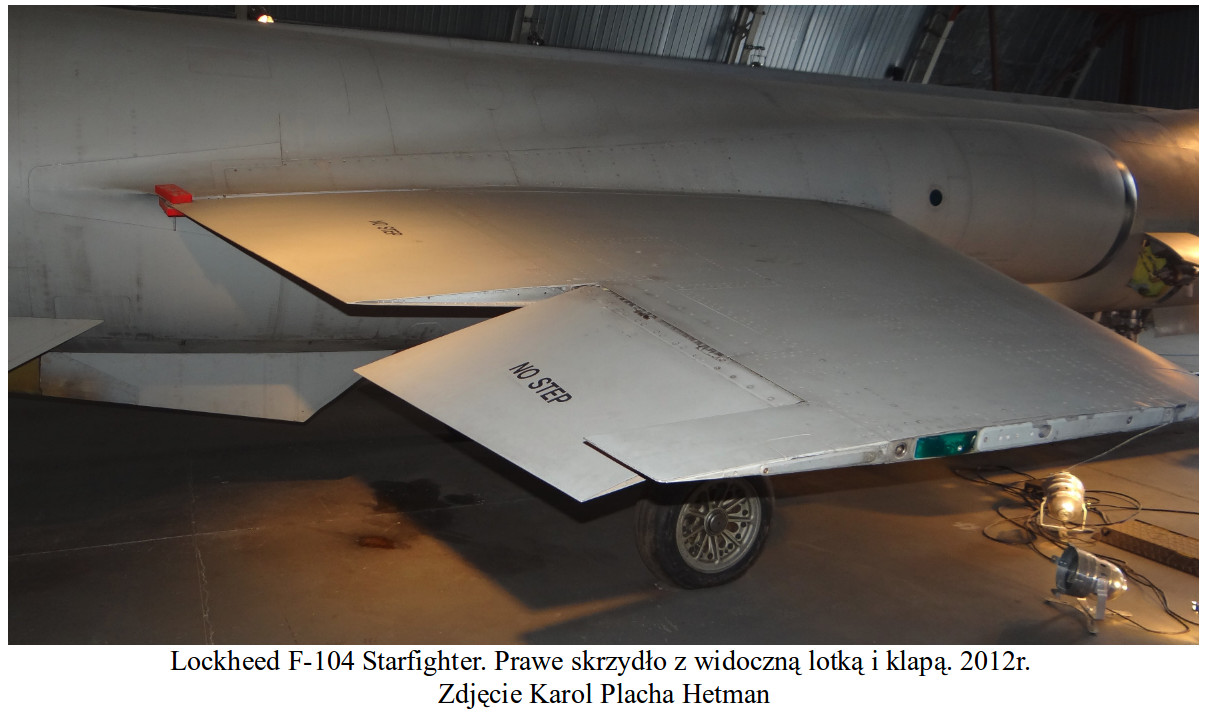
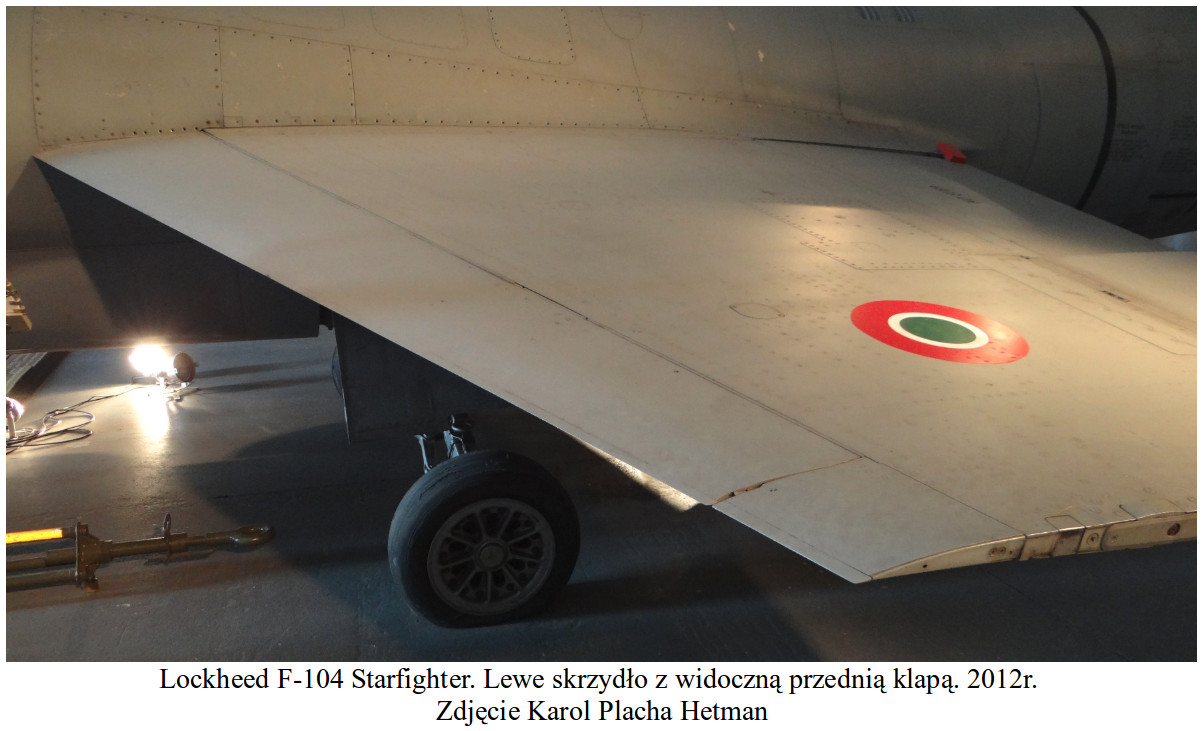
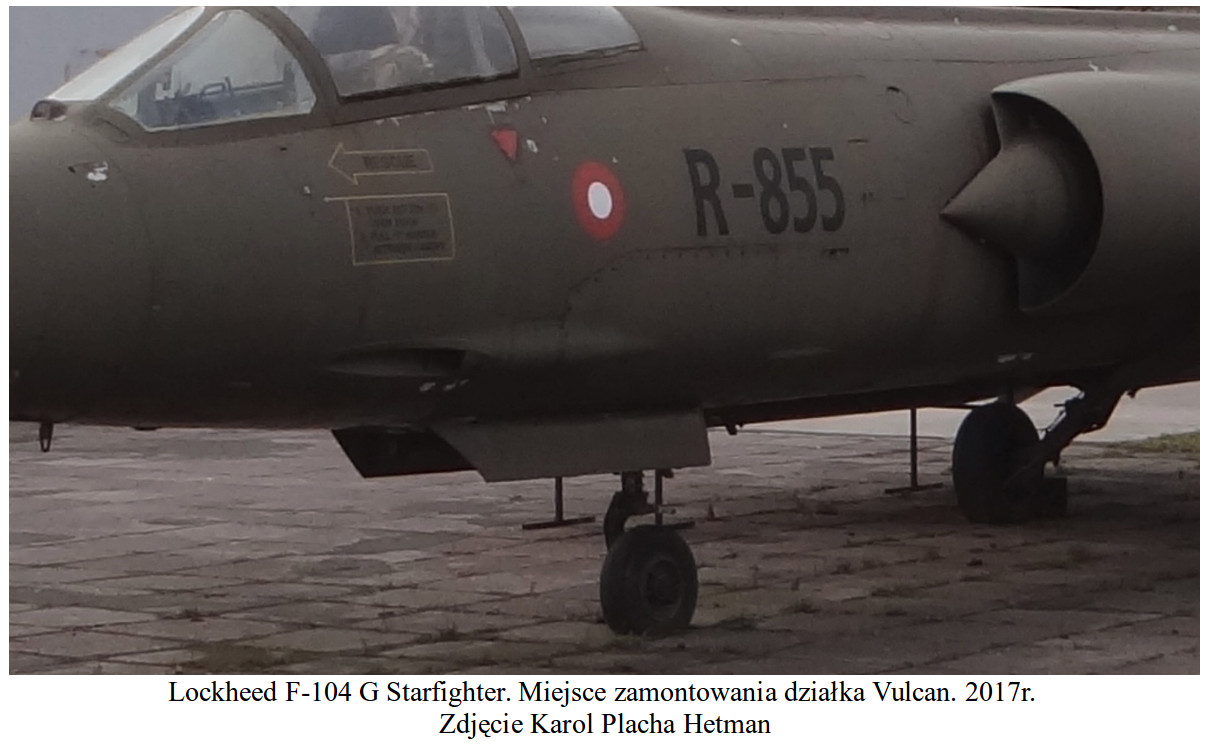
The main armament of the aircraft was the AIM-9B Sidewinder p-p type cpr, and a little later the 6-barrel Vulcan cannon.
The Lockheed F-104 Starfighter was adopted by the USAF in 1958. The F-104 A rescue system turned out to be inappropriate. Catapulting down at low altitude must have ended tragically. The pilots tried to turn the plane over to its back, but this was not always possible. Therefore, it was necessary to change the rescue system.
Lockheed F-104 C Starfighters in Vietnam did average. They had a short range and lifting capacity. The planes had to be refueled in the air. In the first weeks of fighting in 1965, 3 planes were lost to the fire of the Opel. Only one pilot was killed. On September 20, 1965, one Smith pilot got lost and was shot down by a Shenyang J-6, a Chinese MiG-19. The pilot was captured. On the same day, returning from the Smith search, two F-104 Cs collided in the air during the night approach to the landing at Đà Nẵng. Fortunately, both pilots, Harvey Quackenbush and Dayle Carlson, managed to catapult themselves safely and were not injured. In 1966, the F-104 aircraft without radiation warning devices began to fall prey to the S-75 Dvina Z-p class missile sets.
As early as 1967, the F-104 planes were withdrawn from the USAF line and transferred to the National Guard, where they served until 1975.
Even people interested in aviation do not know that the first version of Lockheed F-104 A Starfighter introduced into service did not have a radar station (radar sight). The reason was the attack concept. It was the ground guidance system that was supposed to bring the plane close to the target, and the missile would do the rest. The problem was that the guidance system was only voice commands from the ground station, because the semi-automatic guidance system was not ready yet.
The promotion of the Lockheed F-104 Starfighter in Japan, Canada and Germany was very broad and aggressive towards competitors. So much so that in the 1960s a bribery scandal came to light.
Japan was calm and cautious about arming its self-defense forces, almost completely relying on US goodwill.
Canada's approach to the subject was doubled. The government was doing something else and the public, which could not get over the end of the Avro Canada CF-105 Arrow program and, in fact, the end of the sovereign military aviation industry thought differently. No other Canadian Air Force aircraft met Canada's expectations as much as the Avro Canada CF-105 Arrow. The Lockheed F-104 Starfighter was crammed into Canada. To wipe away tears, Canadians were given a license with the right to produce and export for little money. But the plane needed some retrofitting. The problem was serious, because the radar sight used by the Americans did not have a very large range. In order for the aircraft to be multi-purpose, it had to be equipped with a radar station with greater capabilities. The forward section of the fuselage was enlarged to accommodate the new radar station. To extend the range under the fuselage, two more knots have been added to attach additional fuel tanks. The effect was that the plane had only two additional fuel tanks anyway, but also had two missiles. We should also remember that due to the low-set hull, there was no chance to place anything under the fuselage. Attempts to place a large k.p.r. here failed. With this aircraft layout, the term multi-role was exaggerated. The CF-104 Starfighters were built under license by the Canadian Canadair plant. They were initially designated CF-111. About 200 were built, mostly for the Royal Canadian Air Force (RCAF). This machine was structurally identical to the F-104 G, but powered by the J79-OEL-7 engine produced in Canada by Orenda.
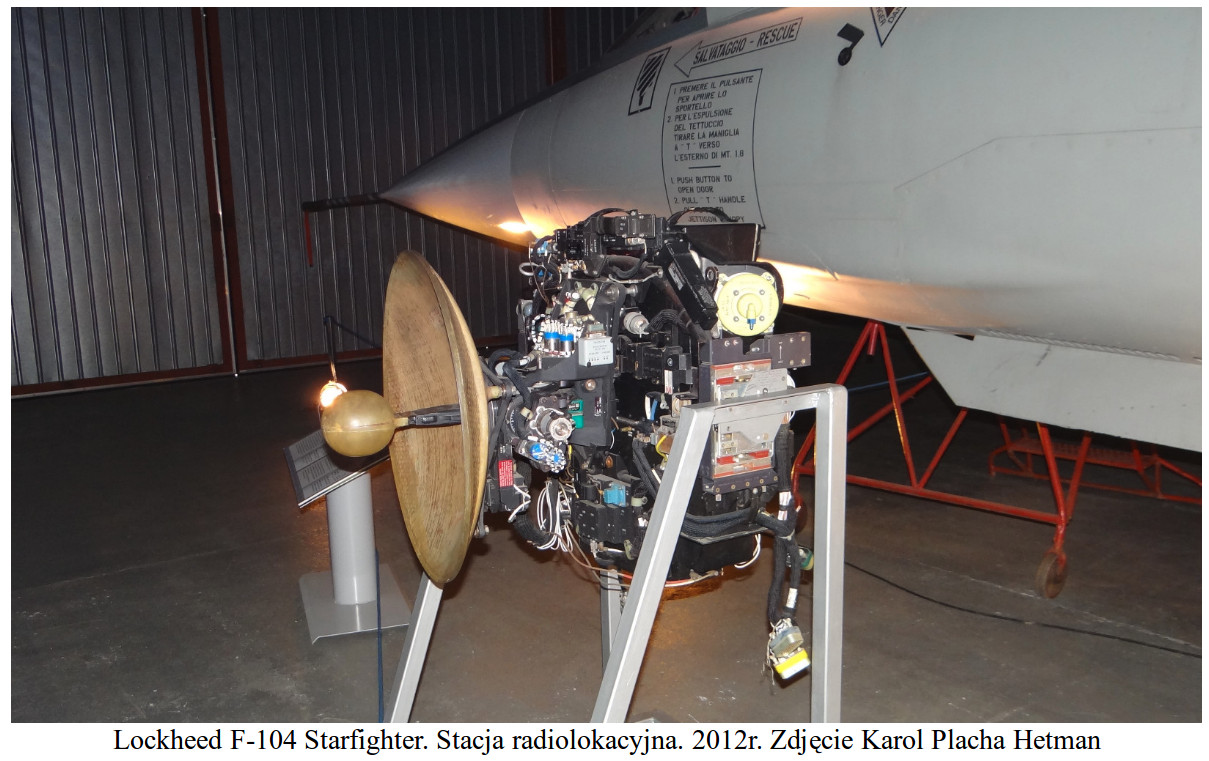
As at that time, Germany was still banned from the production of combat aircraft, therefore the German state willingly joined cooperation with foreign countries. So in Italy and Canada. For the CF-104, the Germans developed reinforced knots and wing spars to make them more loadable. They also participated in the assembly of the radar station.
The Italians with the Lockheed F-104 Starfighter were satisfied. They produced it until 1986. The last version was the F-104 S. The letter S meant AIM-7 Sparrow missiles. The differences compared to the previous version were the use of the improved and more economical J79-GE-19 engine with a thrust of 79.6 kN, more modern avionics, and 9 weapons suspension hooks: 2 under each wing and 1 at the ends, central under the fuselage and 2 in front of the fuselage under the air intakes. The small arms were removed and the fire control system for the Sparrow missiles was installed in its place. However, in the assault versions, the Vulcan cannon has been brought back. A total of 246 F-104 S machines were built for the aviation of Italy and Turkey. The Italians did not complain about the plane. They claimed it was cheaper to produce and maintain than newer machines, and it did the job well.
210 Lockheed F-104 J aircraft were assembled in Japan. The first flight was in 1961. The machines served until 1989, when they were replaced by the McDonnell Douglas F-15 Eagle / Mitsubishi F-15 J. Lockheed F-104 J planes were sold to Taiwan, where they served the following years. The end of their service was to turn them into unmanned aerial vehicles.
It is significant that the second country, after Germany, that had a very large number of Lockheed F-104 Starfighter aircraft was Turkey. About 400 of them were used. There, the plane did not gain much fame.
Lockheed F-104 Starfighter for Germany.
On March 18, 1959, the German Minister of Defense, Franz Josef Strauß, signed a contract for the supply of the first batch of 66 aircraft in the F-104 G (single-seater) and F-104 F (two-seater) versions. The planes were built in the USA. Any voices of criticism were muffled. Military opponents were sent to the civilian. Besides, the resistance was not great. The Germans lived in prosperity and prosperity. There was practically no unemployment and wages were rising systematically. The aged Chancellor Adenauer enjoys universal respect. Nay. There was no criticism of the German policy of 20 years, and the period of Hitler's rule was even considered necessary and that it was an attempt to liquidate seasonal states, such as Poland. CCCP was widely hated in the press, but at the same time economic ties were tightened more and more, treating the Moscow state as a reliable source of raw materials and yourself as a permanent and reliable recipient. A symbol of mutual love, reborn after the mistakes of Hitler and Stalin, is the pipeline running along the bottom of the Baltic Sea, which connects the two countries.
The first of the 66 Lockheed F-104 G Starfighters ordered by Germany from Lockheed was flown on October 5, 1960. When West Germany received its first Lockheed F-104 Starfighters, the Germans were both proud and a little scared at the same time. While the Republican F-84 Thunderstreak was difficult to fly (weak turbine thrust and high payload; 4,000 kg), the Lockheed F-104 Starfighter was very difficult for them.
The training was long and tedious, and most of all with poor results. While the take-off was not too problematic (unless there was a strong side wind), landing was stressful. Maybe not like an aircraft carrier, but some landing features were identical. The F-104 plane had a braking parachute typical of the MiG-21 plane. However, it was placed in a flat container under the fuselage, therefore it could not be released before touchdown. The plane received a landing hook identical to the one on board planes. Although the F-104 never landed on aircraft carriers. All German F-104s received such hooks and brake lines were installed at all military airfields. To be honest, Polish pilots were a little jealous of such an emergency catching system. Because in Poland, the so-called „migo-łapki" were used, i.e. a piece of plowed field behind the end of DS (RWY).
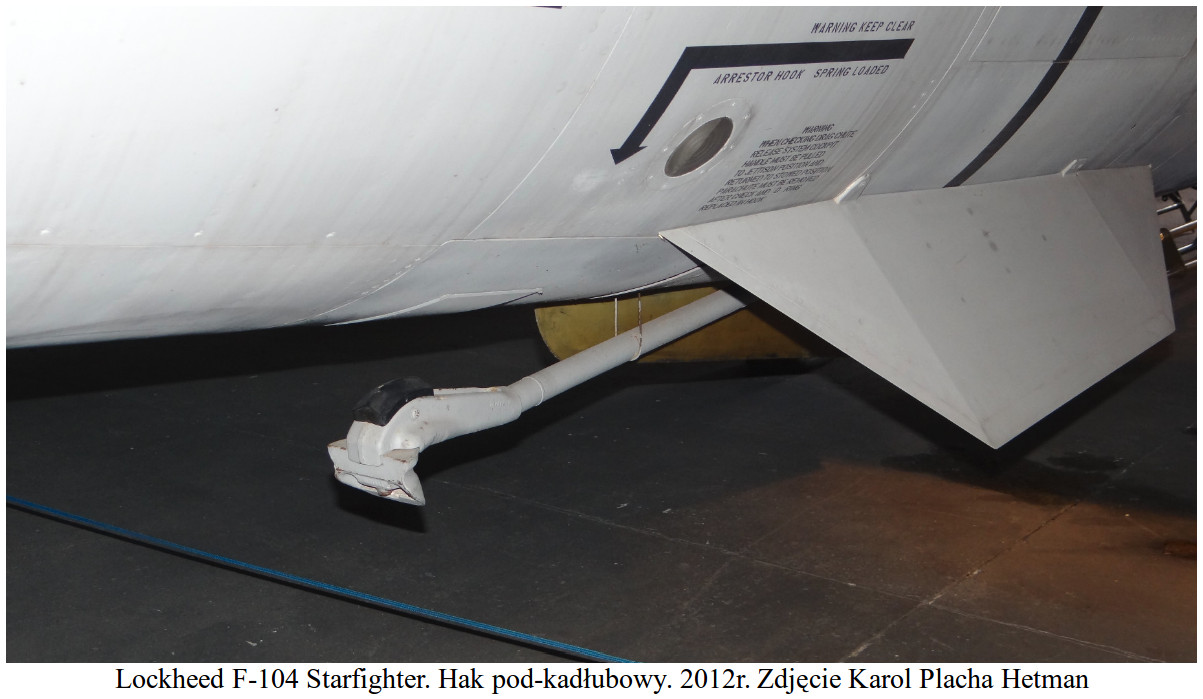
In the 1960s and 1970s, the area of Germany was 248,000 square kilometers and was inhabited by just over 60 million inhabitants. Poland has 312,000 square kilometers and has approximately 38 million inhabitants. Thus, we can see that the population of the Federal Republic of Germany is much higher than that of the Republic of Poland. The result is a small area of exercise yards and training grounds, although their number was similar to the number of such facilities in Poland. What does this have to do with the F-104s? The Germans began practicing low-altitude flights almost immediately to avoid detection by radar stations of the S-75 Daugava surface-to-air missile systems. The effect was that the F-104 ripped the sky low above the heads of its inhabitants. Cracked panes in the windows were not uncommon.
The variant of the Lockheed F-104 G Starfighter, which the Germans had the most, had the ability to carry nuclear loads. At one time, the German authorities, in a fantasy outburst, asked the Americans to give them part of the nuclear arsenal. Apparently they argued that the Polish Army has such an arsenal. It was partially true, because the arsenal of nuclear weapons in the Polish People's Republic (certainly in three facilities) was available only to the Russians. Fortunately, the Americans did not leave common sense. The fact is, however, that in a conflict on a massive scale, the Americans would use nuclear charges without undue delay. Since they could not do it with their own forces, they would hand over their weapons to their allies in Europe. This is not about nuclear war, but let's say to the young reader - Regardless of who started the boarding school, Poland would not exist, and our area would be one radioactive center, stopping the march of foreign conventional troops. The first decisions on this subject were made in 1954. However, officially in 1967, the US administration announced to the German authorities that, even in the event of an armed conflict, they would not be given nuclear weapons. The reason was simple. From the beginning of the 60s, the Russians have been putting missiles on launchers capable of attacking any point in North America. Therefore, a radioactive buffer set up on Polish soil would not stop the CCCP from attacking the US, and the conflict in Europe should only be local and conventional.
As for the OKB Mikojan and Guriewicz MiG-21 planes, there were several dozen in Poland that could theoretically carry a nuclear charge. In 1968, we collected the last 12 MiG-21 PFM machines from the manufacturer. These planes differed slightly from all previously received. Their serial numbers had the letter N, and they were MiG-21 PFM planes from 94 N 7809 to 94 N 7905. In short, machines adapted to attack with nuclear bombs. However, in Poland it did not matter, as there was no such weapon in the state of the Polish Army, and the planes were operated like all the others. These planes were included in the equipment of the Polish Army only because we received planes from a different factory than before.
To close the topic of nuclear weapon carriers in Poland, our Su-7 B stationed in Bydgoszcz was evidently the nuclear strike planes, with the task of attacking the territory of Denmark with nuclear weapons, which we were to get at the right time.
The Germans were still dissatisfied. After all, dissatisfaction is a condition for progress. Finally, in 1962, they forced production of the F-104 in Europe until 1974 (with a break from 1966 to 1970), and in Italy until 1986. The date of 1974 is significant, because then the British-Italian-German Panavia Tornado was flown. Lockheed F-104 Starfighter parts were produced in Germany, Belgium, the Netherlands and Italy. Final assembly was carried out in Italy, and a little later also in West Germany, Belgium and the Netherlands. It was coordinated by the Starfighter Management Office (NAMSO), which was directly subordinate to NATO. Thanks to this cooperation, Western Europe has learned to manage the production of high-tech goods, which has brought results in military and civilian production. The first F-104 G planes were built in the USA. The remaining planes were built in four European consortia formed in 1959-1962. Also in Germany.
In total, 949 F-104 G were built in Europe. In total, 1015 machines were delivered for the air forces of the four countries mentioned above, including 670 for Germany, 120 for the Netherlands, 100 for Belgium and 125 for Italy. Deliveries of these machines ended in 1966. However, in 1968, due to significant aircraft losses in air accidents, the German government purchased an additional 50 F-104 G machines. For this purpose, the ARGE Süd production line was restarted. The assembly line was in operation from November 1970 to March 1974.
Germany used 605 (586) machines of the F-104 G version, 145 (163) machines of the RF-104 G version (reconnaissance), 30 machines of the F-104 F version (two-seater) and 137 machines of the TF-104 G version (two-seater), with which the naval aviation Marineflieger used 146 machines of the F-104 G version and 27 of the RF-104 G versions. Cormorant. The F-104 was used in the years 1960-1991. The planes which they failed to crash were handed over to Turkey (about 150) and to Gracia (about 80).
In Germany, the Lockheed F-104 G Starfighter was dubbed the "Widow Maker - Witwenmacher". It was generally assessed as dangerous and difficult to pilot. Out of about 1,000 F-104s, nearly 300 aircraft were lost and about 120 pilots died (the most common number is 116 people). Importantly, the data is imprecise. There are numbers from about 180 disasters to nearly 300. These facts are a bit surprising considering that in the absence of war it was impossible to precisely count how many of them were disastrous. The minimal excuse was that the military disaster was classified over confidential. However, even in Poland of deep communism it was not like that. (We write here about the 60/70 years, and not about the joyful works of communists of the late 40s.)
The next critical decisions about the Lockheed F-104 Starfighter appeared in the mid-1960s, when another command of the German air force expressed its negative opinion about the F-104. This jeopardized the alliance within NATO. As a result, there were further resignations. Among others, the commander of the German air force, General Werner Panitzki in 1966. The death of the 29-year-old pilot Joachim von Hassel, son of minister Kai-Uwe, who died on March 11, 1970, while flying the F-104, gained publicity.
Politics sheds light on the matter. The undividedly ruling CDU / CSU parties (Christian Democrats, although they have as much in common with Christian values as an ox with a carriage) lost power. Their place was taken by the SPD / FDP (leftism) parties and they started to order their own way. The program of the new MRCA Panavia Tornado was delayed. On June 24, 1971, the Bundestag passed a law to purchase 175 F-4 Phantom aircraft, which, however, had limited combat capabilities. They had weaker radar algorithms and limited missile weapons.
But the Lockheed F-104 Starfighter discredit machine kicked in and the press started to take advantage of the construction. That it was underdeveloped, that the Americans did not finish the entire research program. At the same time, the memory of the fallen pilots was not touched and the respect for families was preserved. Certainly right, but the training program had to be modified then.
It should be assumed that the F-104 planes were not properly selected for the tasks they were to perform. A more suitable plane would definitely be the Grumman F-11 Super Tiger. Although the machine was designed as an on-board machine. This, however, was not an obstacle, because the McDonnell Douglas F-4 Phantom was similarly designed as an on-board plane.
It is also puzzling to provide information about numerous failures of Lockheed F-104 Starfighter aircraft. Is it right?
The Lockheed F-104 G Starfighter had one of the best engines of the 20th century, the General Electric J-79. So good that it was used in many combat designs, including the famous Lockheed U-2. The Russians were so impressed with the engine that they copied its adjustable stators and used it in the Al-21 engine (introduced into service in 1969), which is still used in OKB Sukhoi Su-22 planes. In order to lead to a breakdown, such an engine needs to be serviced sloppily or not at all. The phenomenon of pumping the General Electric J-79 engine practically did not occur. Unless the engine was poorly maintained. The fact is that the engine stalling on a combat aircraft at that time was a problem. And in Poland such cases have happened. If the pilot was to reach altitude, he could try to start the engine from autorotation. There were several articles in the specialist press about restarting the engine of OKB Mikojan and Guriewicz MiG-21, and even OKB Suchoj Su-20 aircraft. If the ceiling was not reached, the pilot ejected. So the problem wasn't in the engine.
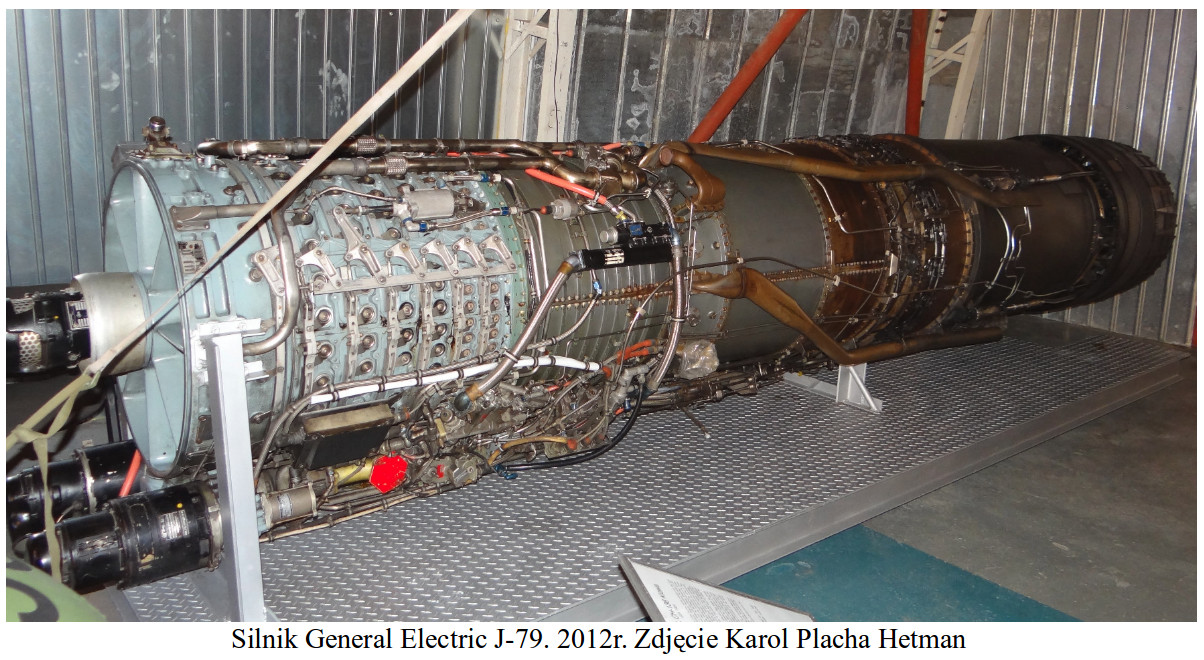
Maybe an electrical installation? In airplanes, the power generator and the batteries could fail at the same time, so the plane was not without electricity. Automatically, a small turbine emerged from the port side and provided the necessary energy to return safely to the airport. After all, with such a failure, this plane did not perform the task anymore. The turbine also maintains the proper pressure in the hydraulic system.
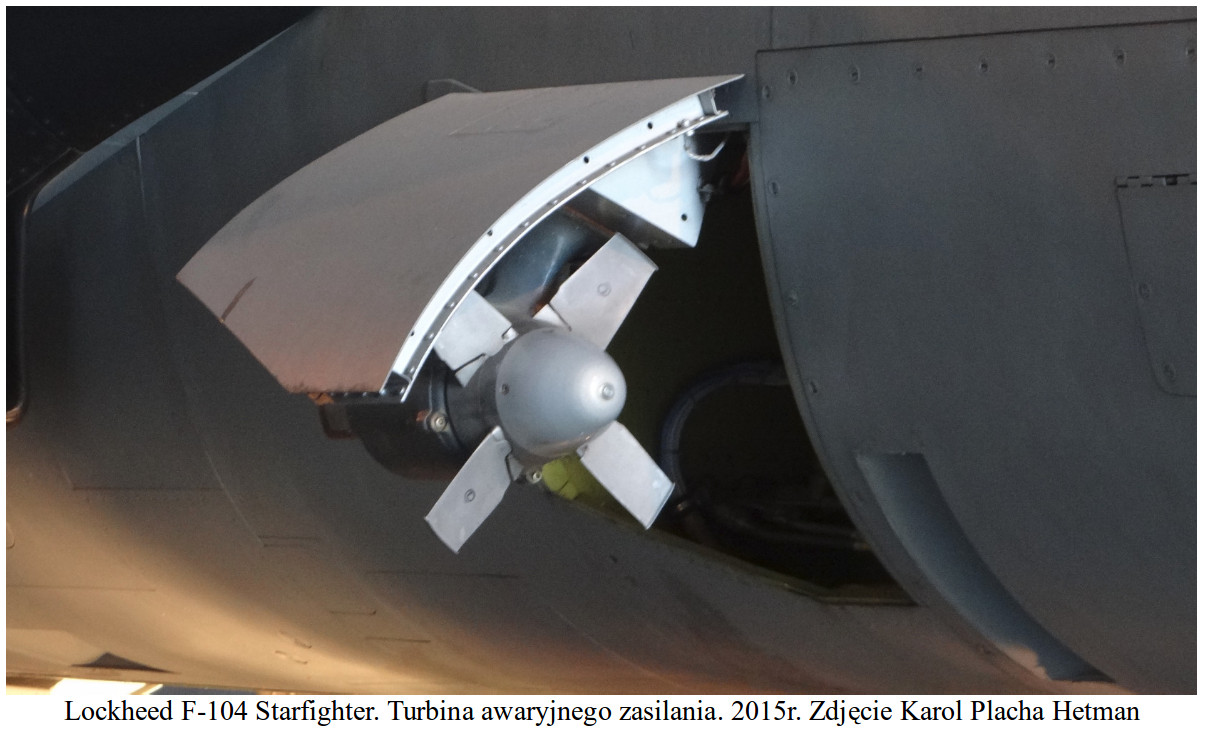
Maybe the landing gear did not extend? The F-104 has one of the simplest chassis kinematics. Only a fixed undercarriage could be simpler. Even if the hydraulic system fails, the chassis can still be pulled out under its own weight. It is true that the stroke of the shock absorbers is small, which, in the event of an incorrect touchdown, can cause the planes to bounce off the RWY, tip over and crash.
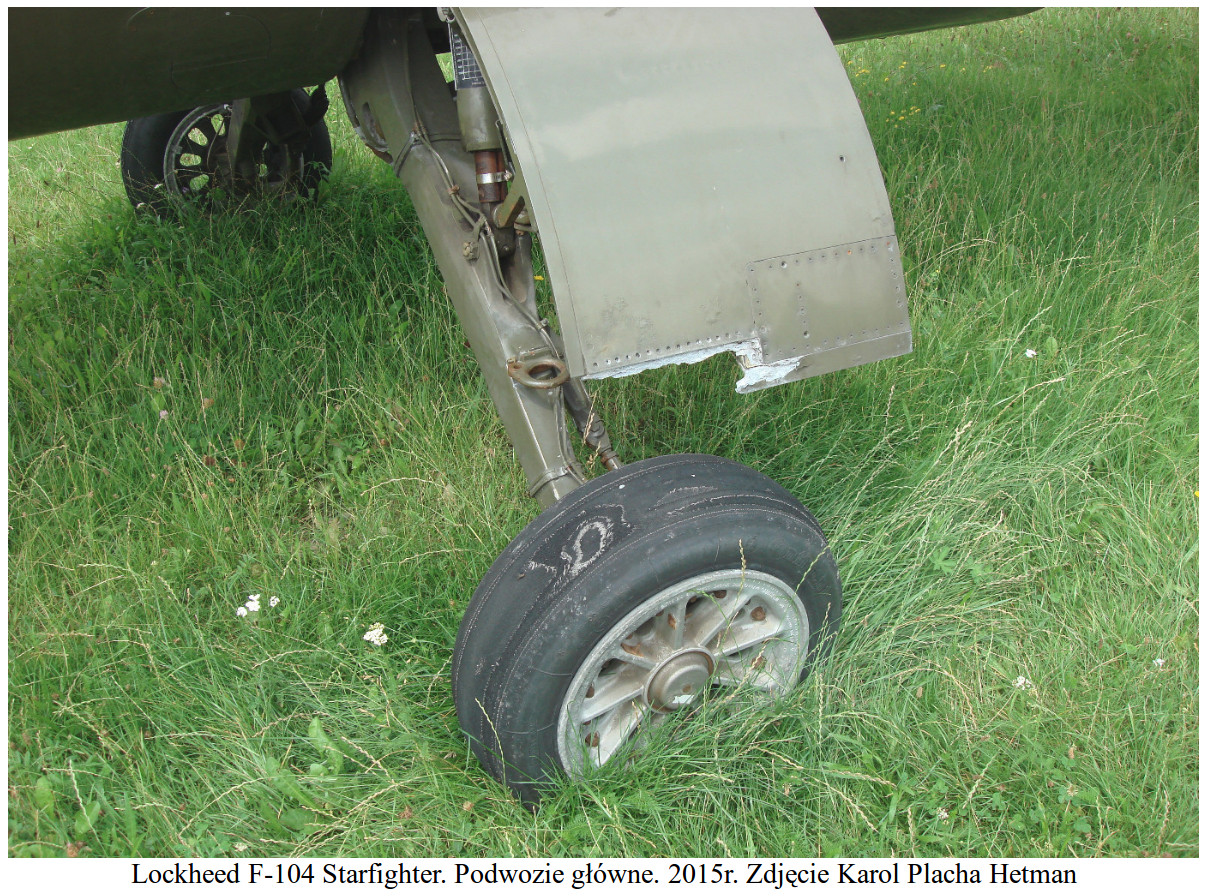
Maybe an unreliable catapult chair? However, the F-104 was equipped with zero-zero class zero-zero Martin-Baker seats. The Martin-Baker company is a world leader in this type of equipment. And their seats have been and are fitted to almost all Free World aircraft.
Maybe an unreliable control system? If it had been so long ago, it would have been redesigned and redone. Single copies of the F-104s were used by NASA in the 90s of the twentieth century and there was no accident.
On both edges of the wings, along the entire length of the wings, flaps: attack and trailing flaps were installed, in addition, BLC (Boundary Layer Control) flaps were installed, improving the flight characteristics of the machine at low speeds and during landing. The F-104 was the first aircraft with the BLC system, thanks to which, despite its slim silhouette and short wings, the landing speed of the machine was comparable to other fighters of the time.
The plane is really simple and uncomplicated. There is nothing to break down there, because there is not much electronics. The radar is the most complicated, but it is not a reason for the plane to crash.
Nevertheless, it can be presumed that the training of German pilots was poor, not to say tragic. The Germans had neither the experience nor the time to train their pilots well. Turbojet airplanes fell like manna from heaven and they had to be put into service as soon as possible. The German boot was so great that they did not take advantage of offers from the USAF army to train in the USA, where a special training division was created for the countries that operated Lockheed F-104 Starfighters.
Written by Karol Placha Hetman
